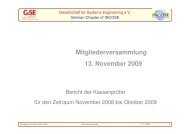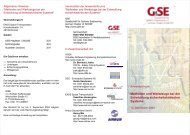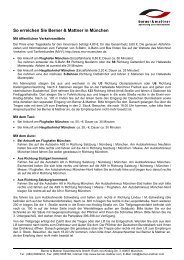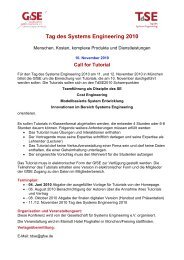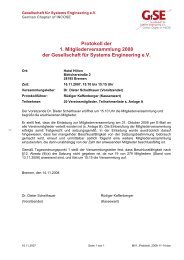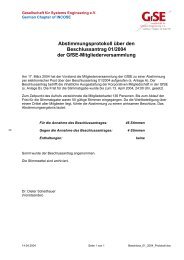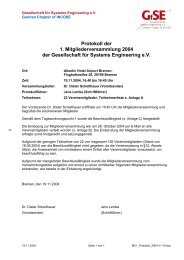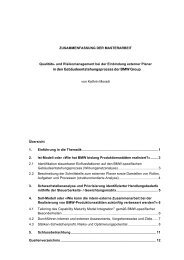Summary of Diploma Thesis_Christian Eger - GfSE
Summary of Diploma Thesis_Christian Eger - GfSE
Summary of Diploma Thesis_Christian Eger - GfSE
You also want an ePaper? Increase the reach of your titles
YUMPU automatically turns print PDFs into web optimized ePapers that Google loves.
Zusammenfassung der <strong>Diploma</strong>rbeit<br />
<strong>Summary</strong> <strong>of</strong> the <strong>Diploma</strong> <strong>Thesis</strong><br />
Design- & Development Planning for a<br />
European Crew Transportation System<br />
<strong>Christian</strong> <strong>Eger</strong><br />
Universität Stuttgart<br />
Institut für Raumfahrtsysteme<br />
EADS Astrium GmbH<br />
1 Introduction<br />
The Advanced Return Vehicle 1 (ARV) is a concept study for a future European crew<br />
transportation system, proposed by EADS Astrium GmbH. The modular vehicle shall be<br />
capable <strong>of</strong> transporting astronauts and payloads to the International Space Station (ISS) or<br />
other destinations in an earth orbit and returning them safely to earth. With the<br />
implementation <strong>of</strong> an operational crew transportation system as the ultimate goal, the<br />
programme shall be realized with two implementation milestones in order to limit the<br />
development risks:<br />
Milestone 1: Implementation <strong>of</strong> Cargo Download Capability not later than 2016<br />
First, cargo download capability from LEO shall be implemented. While preserving the<br />
maximum synergy with the final crew transportation system, an unmanned cargo version <strong>of</strong><br />
the vehicle shall be capable <strong>of</strong> transporting payload to the ISS and returning conditioned and<br />
unconditioned payload to earth. [1]<br />
Milestone 2: Implementation <strong>of</strong> Crew Transport not later than 2019<br />
The second implementation stage, shall upgrade the cargo download system to a manned<br />
transportation system. The final vehicle shall be capable <strong>of</strong> transporting crew and payload to<br />
the ISS and returning them safely to earth.<br />
1 from July 2009 “Advanced Reentry Vehicle”<br />
1
The heritage <strong>of</strong> know how and the lessons learned from preceding concept studies allowed<br />
an early set-up <strong>of</strong> a system concept for ARV, including several configuration options.<br />
Basically, all potential configurations consist <strong>of</strong> a re-entry capsule on top <strong>of</strong> the vehicle and a<br />
service module, with different variations <strong>of</strong> size and performance for both <strong>of</strong> them. ARV shall<br />
be launched with Ariane 5 from the European launch site in Kourou.<br />
Advanced Return Vehicle (ARV) Configuration Concept<br />
2 <strong>Thesis</strong> Objective<br />
The first objective <strong>of</strong> this thesis was to compile an overall development approach for this<br />
crew transportation system, resulting in a Preliminary Design- and Development Plan as<br />
output to ESA. Based on the two implementation milestones given above, the plan should<br />
specifically address the technical tasks to be done in the early phases <strong>of</strong> the ARV<br />
programme. It should assess the current maturity <strong>of</strong> essential technologies for a Crew<br />
Transportation System and present suitable development- as well as verification-approaches<br />
for ARV, which initially commensurate with the objectives <strong>of</strong> the cargo download capability,<br />
but preserve maximum synergy with the final crew transportation system. As part <strong>of</strong> the plan,<br />
also a development schedule showing the timely planning <strong>of</strong> the development activities and<br />
their interrelation should be compiled.<br />
The second aim <strong>of</strong> the thesis was to convert the project-specific planning and the technology<br />
analysis results for ARV into a generalized form in order to make them accessible for the<br />
academic environment, in particular for the Space Station Design Workshop (SSDW), which<br />
is <strong>of</strong>fered by the Institute <strong>of</strong> Space Systems every year. Potential applications <strong>of</strong><br />
development approaches in the SSDW through adequate tools should be derived and<br />
described.<br />
2
3 Compilation <strong>of</strong> the Design and Development Plan for ARV<br />
Design and development planning means identifying the major development tasks to be<br />
done when implementing a new space system and defining the guidelines and approaches<br />
how these tasks shall be performed. The planning concept is then documented in dedicated<br />
project plans. A classic way to do this is establishing <strong>of</strong> a so called design and development<br />
plan (in the following: D&D plan). The D&D plan is the basic technical plan that serves as<br />
master document for further technical sub-plans which detail specific sections or aspects <strong>of</strong><br />
the development process (e.g. assembly, integration and verification). The preparation <strong>of</strong><br />
these plans is a typical system engineering activity that usually starts in the second phase <strong>of</strong><br />
a project after the system concept has been defined. Since there already existed a system<br />
concept for ARV during the first project phase, it was possible to set up a preliminary D&D<br />
plan. As a concept-version <strong>of</strong> the D&D plan it should not go into deep detail, but focus the<br />
overall technical tasks and approaches that have to be performed at system- and subsystem<br />
level. Also some essential approaches for the verification <strong>of</strong> system elements and<br />
subsystems should be presented, especially for the technologies which would be new to the<br />
European manned spaceflight.<br />
The D&D plan was established in several steps as given below which also roughly reflect the<br />
structure <strong>of</strong> its content.<br />
Definition <strong>of</strong> an Overall Design & Development Logic<br />
Technology Readiness Analysis<br />
Preliminary Model Philosophy<br />
Engineering Management Approaches<br />
Specific System Engineering Tasks and Approaches<br />
Subsystem/Discipline- Specific Engineering Tasks and Approaches<br />
The different configuration options for the vehicle and fundamental technology options at<br />
system- and subsystem level, were respected in the planning as far as they impacted the<br />
principal course or the duration development process. However, most <strong>of</strong> the plan was<br />
prepared independent <strong>of</strong> technology options, in order to decouple the development flow itself<br />
from detailed technical solutions that will finally be chosen.<br />
Definition <strong>of</strong> an Overall Design & Development Logic<br />
First, an overall logic was established that shows the main development steps leading to the<br />
operational system and identifies their interdependency. At system level, the logic had to<br />
consider all segments <strong>of</strong> the ARV system, the space segment (vehicle with its modules), the<br />
launch segment (the Ariane 5 launcher and related facilities at the launch site) and the<br />
3
ground segment (ground control centres, support facilities etc.). It shows the implementation<br />
steps over time for all main elements <strong>of</strong> the segments under the constraint that the final crew<br />
transportation capability could be deployed within only three full launches <strong>of</strong> the vehicle. For<br />
vehicle itself, also an evolution logic <strong>of</strong> the subsystems was established.<br />
Schematics <strong>of</strong> the ARV Development Logic<br />
Further parts <strong>of</strong> this section, were dedicated to show in how far the potential reuse <strong>of</strong> the<br />
existing ATV spacecraft as service module for the cargo version <strong>of</strong> the vehicle would affect<br />
the development process and to set up a preliminary flow <strong>of</strong> the initial trade-<strong>of</strong>fs at to be<br />
made at system and subsystem level.<br />
Also the formal project phasing and the formal project reviews were defined. In large parts<br />
the common approach for space projects with the development phases 0, A,B,C,D with the<br />
typical reviews was adopted. At this point, only some additional reviews and the adaptation<br />
that there should be common requirements analysis and feasibility analysis activities for both,<br />
the crew- and the cargo version <strong>of</strong> the vehicle were included in the planning.<br />
Technology Readiness Analysis<br />
In order to get an overview <strong>of</strong> the maturity <strong>of</strong> the technologies required for ARV and hence<br />
the need for further development, a technology readiness analysis was made. The analysis<br />
was performed under the assumption that ARV will be an autonomous European<br />
development, meaning only the readiness <strong>of</strong> technologies in Europe was considered and no<br />
existing systems or demonstrators in the USA or Russia were embraced.<br />
First, a detailed technical breakdown <strong>of</strong> the complete system was made for each segment as<br />
far as possible due to the level <strong>of</strong> detail <strong>of</strong> the system concept. Most <strong>of</strong> the space segment<br />
4
could be decomposed down unit level, for the launch and ground segment the breakdown<br />
was limited to the major system elements. Following this breakdown, experts at EADS<br />
Astrium were inquired, <strong>of</strong>ficial information from supplier websites was collected and<br />
technology analysis and technical documentation from previous programmes, such as<br />
Columbus, ATV and ATV Evolution was reviewed. Based on the collected information, the<br />
maturity <strong>of</strong> technologies could be evaluated via so called “Technology Readiness Levels”<br />
(TRL) which classify the development status <strong>of</strong> a technology by means <strong>of</strong> levels from 1 for<br />
the lowest maturity to 9, meaning fully operational. For assessing the readiness <strong>of</strong> the<br />
technologies, not only their pure implementation in the past or a coming implementation in<br />
the future was taken into account. Also, further reaching aspects, such as their qualification<br />
status for manned spaceflight or their reproducibility played a role. Useful background<br />
information, such as the current availability in Europe and earlier space systems in which the<br />
technology had been used already, were added.<br />
The results could prove that the essential technologies for a manned transportation vehicle<br />
are available in Europe and that they are partly well developed. Yet, many <strong>of</strong> them have<br />
never been applied in an operational system and could not prove their reliability under<br />
requirements similar to those <strong>of</strong> the ARV.<br />
Technical System<br />
Breakdown<br />
Technology<br />
Options for<br />
Implementation<br />
TRL<br />
Level<br />
(1-9)<br />
Clipping <strong>of</strong> the TRL Analysis Breakdown<br />
Additional Information<br />
(Potential Suppliers/<br />
Developers, Heritage from<br />
other systems<br />
Relevance<br />
(Crew/Cargo)<br />
5
Preliminary Model Philosophy<br />
Testing and qualification <strong>of</strong> the system- and subsystem-design requires models. This<br />
includes digital mock-ps (e.g. CAD models), s<strong>of</strong>tware models, simplified engineering models<br />
<strong>of</strong> hardware, or qualification models identical to the final flight hardware. Depending on the<br />
intended approach for the verification <strong>of</strong> the system, a selection <strong>of</strong> models has to be<br />
determined in such way that the qualification <strong>of</strong> the system versus its requirements can be<br />
achieved, but the model costs are kept as low as possible on the other hand.<br />
For ARV, a preliminary selection <strong>of</strong> the basic models for the main the capsule, the service<br />
module and for subsystems, which would involve new technologies, was chosen based on<br />
the results <strong>of</strong> the technology readiness analysis and a review <strong>of</strong> the model philosophies<br />
proposed in previous concept studies. These were then checked against the experiences<br />
made in the qualification process <strong>of</strong> realized space systems, (e.g. Columbus and ATV) and<br />
also adapted to the technical experience <strong>of</strong> potential subcontractors who were considered to<br />
become the developers <strong>of</strong> the respective system parts.<br />
Engineering Management Approaches<br />
This section was dedicated to the question which control instruments are required to assure<br />
that the coming engineering work in the ARV program will be performed efficiently and that<br />
technical risks can be identified and controlled early in the development process. In project<br />
reality this is assured by dedicated control boards. Therefore suitable types <strong>of</strong> control boards<br />
were collocated (e.g. Configuration Control Board, Change Control Boards) and some basic<br />
rules for the formal process how they should work were defined.<br />
Additionally, general areas <strong>of</strong> responsibility <strong>of</strong> were defined and allocated to the different<br />
parties involved in the development process, meaning the prime contractor, subsystem<br />
contractors, part suppliers etc.<br />
Specific System Engineering Tasks and Approaches<br />
The identification <strong>of</strong> special system engineering tasks itself and the presentation <strong>of</strong> suitable<br />
approaches how to perform them makes typically the largest part <strong>of</strong> a D&D plan.<br />
For the preliminary plan this part was mostly reduced to the mere identification <strong>of</strong> the system<br />
engineering tasks and to the review <strong>of</strong> existing D&D plans for approaches that had proved to<br />
be successful and could be adapted to ARV or even taken over unchanged. Also ECSS 2<br />
development standards that could potentially be applied for these approaches were identified<br />
and taken into account. Only some examples for the topics that were addressed are:<br />
2 European Cooperation on Space Standardisation: Joint board <strong>of</strong> Space Agencies and European<br />
space companies that establishes common standards for development activities in space business<br />
6
• Requirements Engineering: definition <strong>of</strong> the rules how requirements shall be<br />
decomposed, how they shall be fixed in specifications and how the shall be tracked.<br />
• Overall Physical System Design:<br />
o Resources Control concepts: basic concept, how limited system resources (mass,<br />
power, etc.) should be allocated to subsystem design teams.<br />
o Failure Detection Isolation and Recovery (FDIR): basic concept how the system<br />
shall be monitored, malfunction shall be detected and how they shall be recovered.<br />
o Human Factors Engineering: Overall concept to ensure habitability <strong>of</strong> the system<br />
and the safe and efficient interaction <strong>of</strong> humans (esp. astronauts) with the system.<br />
Overview <strong>of</strong> the Approach for Decomposition <strong>of</strong> ARV Specifications<br />
Subsystem/Discipline- Specific Engineering Tasks and Approaches<br />
Beside the overall system engineering tasks, also the development <strong>of</strong> subsystems is<br />
addressed in a D&D plan. Pending on the type <strong>of</strong> system, this content can be grouped into<br />
the parts:<br />
• Mechanical Engineering<br />
• Avionics Engineering<br />
• Propulsion Engineering<br />
• Operations Engineering<br />
However, for bigger and more complex space systems like ARV, these parts are usually<br />
detailed in additional sub- D&D plans, describing the engineering tasks and approaches for<br />
7
specific subsystems. The system D&D plan in this case only contains short summaries <strong>of</strong><br />
them.<br />
For the ARV preliminary D&D plan it was preferable to limit this section to such short<br />
summaries, purely because <strong>of</strong> the low level <strong>of</strong> detail at this point in time. In close<br />
collaboration with the respective experts <strong>of</strong> the team in Bremen, short overviews <strong>of</strong> the<br />
subsystem specific workflows were elaborated for some subsystems. For others again, best<br />
practices from previous development plans were traced and adopted and the potentially<br />
applicable ECSS standards were identified.<br />
Especially the parachute landing system and the Thermal Protection System (heatshield)<br />
would both involve new and even critical technologies. Therefore also some initial proposals<br />
for their verification were presented, including a set <strong>of</strong> essential tests and test-models, as<br />
well as mandatory analyses to be made.<br />
Scheduling<br />
As mentioned in the beginning, several principal options for the configuration <strong>of</strong> the vehicle<br />
existed, some <strong>of</strong> them having great impact on the development time. However their feasibility<br />
had not been proven, yet. This uncertainty was again overlaid by an essential “make or buy”<br />
question that more and more emerged for the launch escape system and would also have<br />
great impact on the overall development time. Combined with some minor uncertainties<br />
about subsystem technologies, this resulted in a variation bandwidth for the development<br />
time which did not allow making a tenable schedule without any outstanding expert<br />
experience. Therefore scheduling was resigned.<br />
4 Derivates for the Space Station Design Workshop<br />
First <strong>of</strong> all a comprehensive overview <strong>of</strong> the background for design and development<br />
planning and the principal content <strong>of</strong> a D&D plan was summed up in a universally valid<br />
manner.<br />
As second step, a generalisation <strong>of</strong> the technology readiness analysis made to the European<br />
manned spaceflight in general was made: In order to provide the SSDW organisation team<br />
and coming student design teams with a comprehensive overview <strong>of</strong> the current<br />
technological status in Europe, the technology readiness analysis performed for ARV was<br />
extended by adding also technology options to the system and subsystem hardware which<br />
were not considered for ARV and considering also additional space hardware items that<br />
were not part <strong>of</strong> the ARV system. For most <strong>of</strong> the items in the breakdown, also available<br />
manufacturers in Europe could be identified and added (independent from the subcontractor<br />
pre-selection <strong>of</strong> Astrium).<br />
8
Based on the experiences gained from the project specific planning activities for ARV, it was<br />
now intended to derive planning tools and aspects that could be useful for the SSDW. The<br />
challenging aspect in making these derivates was to adapt potentially relevant methods to<br />
the completely different prerequisites in the SSDW:<br />
Real projects: In real projects planning<br />
begins after a basic system concept has<br />
been established and the planning mainly<br />
affects the design definition and verification<br />
activities in the coming phases. The<br />
planning is revised and updated throughout<br />
SSDW: The design teams in the workshop<br />
though, start form zero and have to develop<br />
a system concept for a certain space<br />
system within only one week. This means<br />
there is no groundwork to build up on and<br />
few time for planning activities.<br />
the development phases.<br />
Therefore it was necessary to filter out only those methods and tools which could really help<br />
to improve the teams’ design results or which could help to improve the concept definition<br />
process itself. For each <strong>of</strong> them a short concept description was made, how they could be<br />
incorporated as tool in the SSDW. A short overview <strong>of</strong> proposals for the SSDW that are<br />
described in the thesis in more detail is given in the table below:<br />
Development Planning Activity<br />
Concept Derivate for the SSDW<br />
- Nomination <strong>of</strong> a Chief System Engineer in each team<br />
Purpose: Better control <strong>of</strong> the design activities within the<br />
teams and responsibility allocation for the proposals<br />
presented below:<br />
Requirements Engineering<br />
Development Logic<br />
Resource Control & Margin<br />
Technology Readiness<br />
Assessment & Model<br />
Philosophy<br />
Simplified process for requirements decomposition in<br />
connection with function- and product trees<br />
Purpose: help the design teams in defining their mission<br />
and system requirements and in assuring the compliance <strong>of</strong><br />
their system with them<br />
Setup <strong>of</strong> a basic development logic<br />
Purpose: Early checks <strong>of</strong> elaborated space station concepts<br />
and future lunar base concepts for their general<br />
implementation logic and avoidance <strong>of</strong> conceptual mistakes.<br />
Simplified resource control process from the very beginning<br />
<strong>of</strong> the concept design process via an interactive electronic<br />
resource data bank<br />
Purpose: Avoidance <strong>of</strong> late redesigns due to overconsumption<br />
over system resources.<br />
Utilization <strong>of</strong> the TRL analysis results as “check-back library”<br />
and Identification <strong>of</strong> essential test models<br />
Purpose: Check <strong>of</strong> the concept ideas for their realism and<br />
feasibility within time boundaries. Estimation <strong>of</strong> the<br />
development risk resulting costs<br />
9




